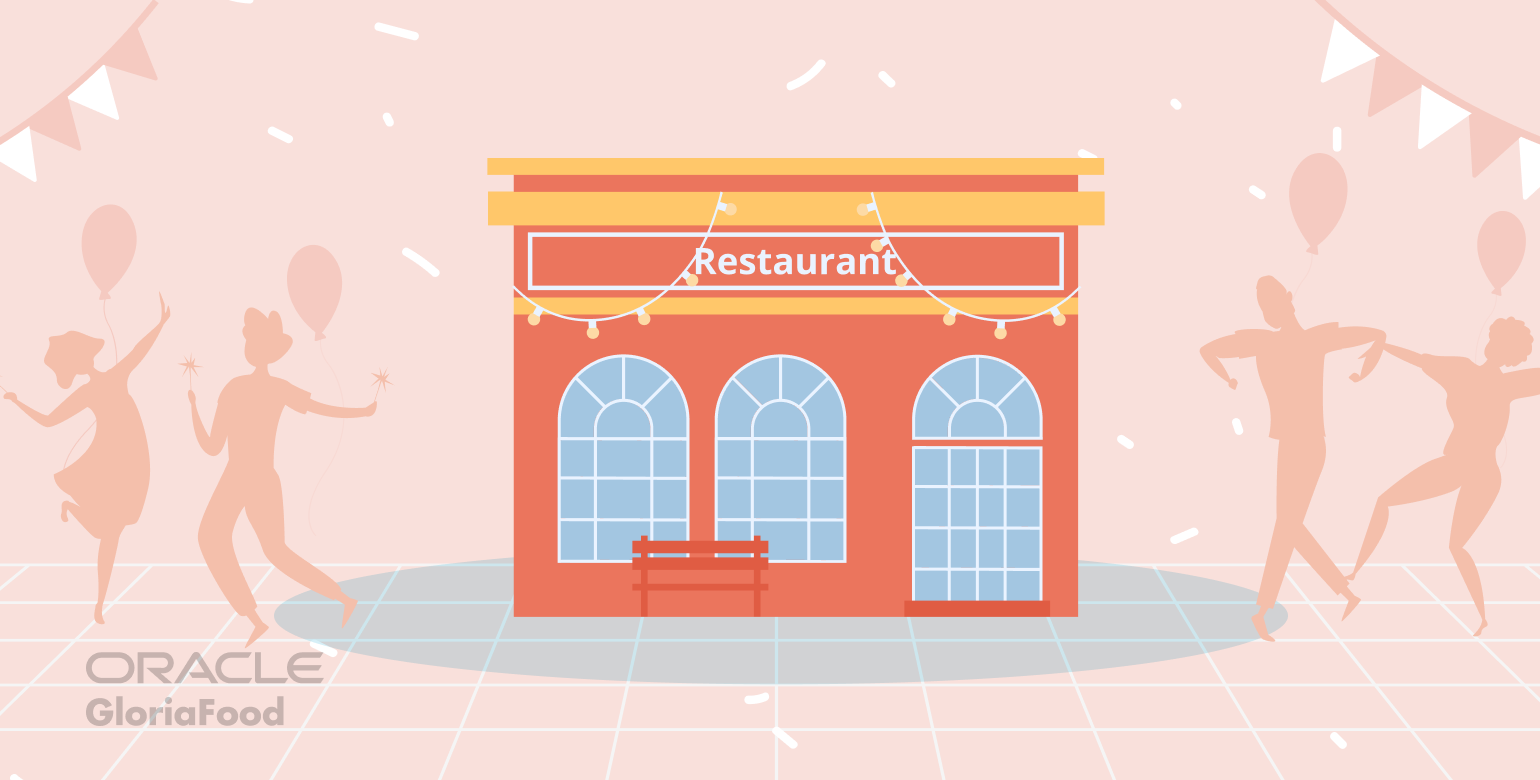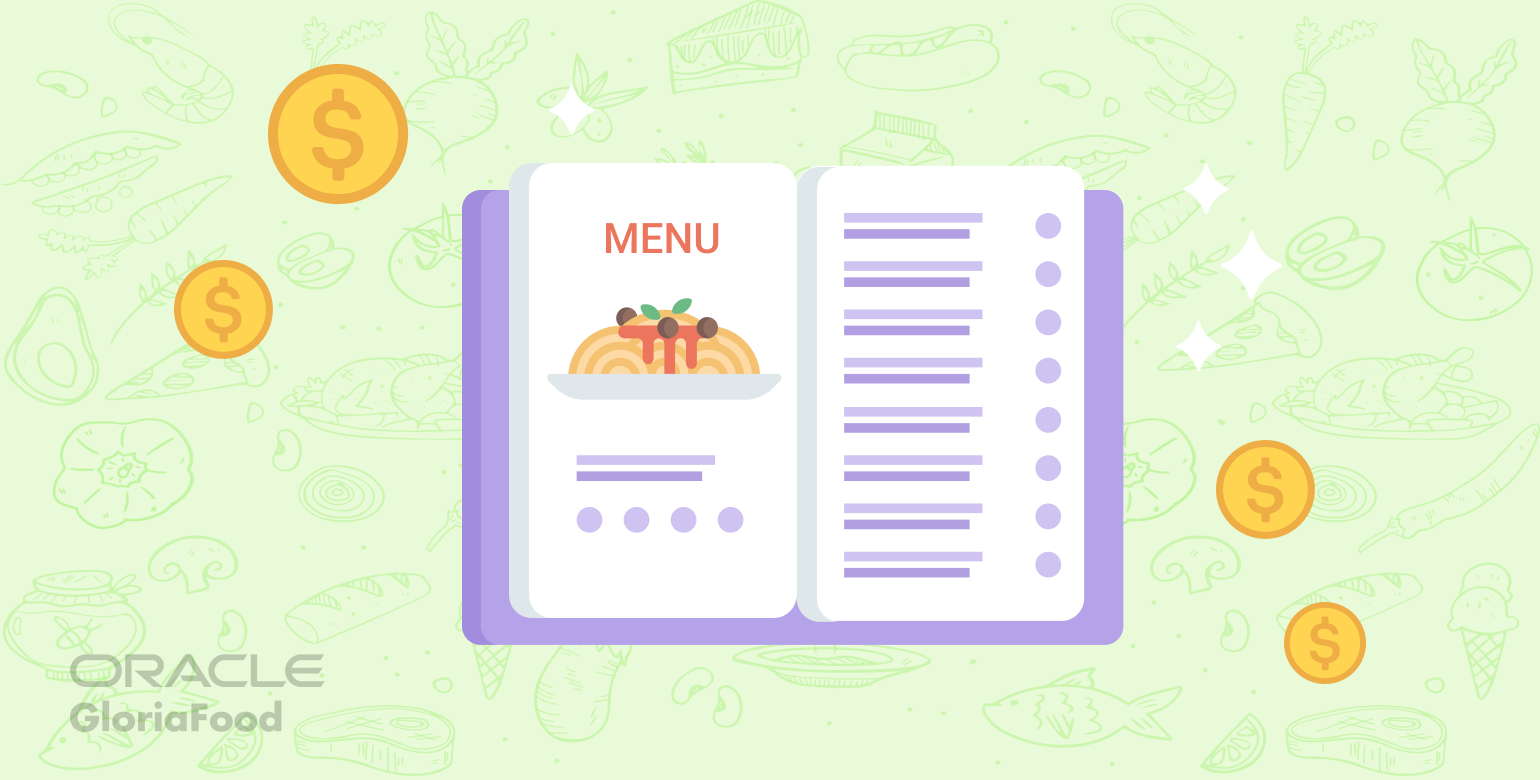- Trigger the senses with longer menu food descriptions
- Use location to suggest quality
- Incorporate diets, customs and religion
- Create a nostalgic backstory for your restaurant menu items list
- Emphasize the cooking process in the restaurant food description
- Use these restaurant menu descriptions examples to draw inspiration from
- Write funny menu descriptions of food
- Use good quality photos
- Update your restaurant menu descriptions to keep the content fresh
- Menu writing mistakes you should avoid
- Don't use complicated menu description words
- Stay away from negative words
- Eliminate currency signs
- Don't make the menu too long
- Don’t ignore your audience
The menu has been called “a map that encourages easy navigation between hunger and satisfaction.” Mouthwatering restaurant menu descriptions can make your clients crave your offerings and happy patrons come back many times.
We aim to help you create fancy food descriptions in less time than it would take the average restaurant to serve you drinks. Studies show that your business can benefit tremendously from doing so. In fact, applying just a few menu writing tips, you could sell up to 30% more food.
Be sure to get yourself a sandwich or at least a tall glass of water if you are dieting, because we are going to talk about the top seven ways to write a menu that sells more by making you very hungry. We are also going to cover the most common mistakes in writing fancy menu descriptions and how you can avoid them.
While some beginner restaurateurs might think that the menu is just a food list, savvy people in the industry know that restaurant menu descriptions make as much as a difference as menu pricing.
Even researchers were curious if people spend more when the menu descriptions are appetizing. A study from 2019 shows that the menu description triggers 45% of the buying decision for a specific dish.
The same paper identified the main categories of restaurant description words that have an impact on the client’s decision to order those items. The following factors have the biggest influence for clients selecting a dish:
- Identifying the food as local;
- Giving proof that the recipe is made with organic ingredients;
- Items that promote a sense of place;
- Explaining the ingredients in the local language;
- Using sensory words;
- Including sentimental references.
Does this sound difficult to do? We are here to help and provide simple dos and don’ts. By the power of example, you will be able to create food descriptions that have orders flying out to your kitchen faster than the cooks can make them.
We’ve compiled a list of tips & tricks that will help you write irresistible menu descriptions:
Each item on your menu should have an attractive name and either a list of ingredients or a persuasive description.
The name of the dish, however, should be self-explanatory. Clients need to understand what each item means at a glance and read the entire menu item description only if they are curious.

When writing a menu for a restaurant, you need to find the right balance between the number of words you use to convince customers that they are getting a good deal and keeping their attention. For a higher price, it is best to list more explanations and ingredients to justify it.
Think about what makes each dish unique. Write down adjectives focusing on smell, taste, texture, or the cooking method.
- Meat can be smoky, spicy, well-done, tender, juicy, lean, or aged.
- Vegetables can range between fresh, earthy, and zesty.
- Sauces are sweet, sour, bitter, tangy, rich, or fruity.
You don’t need an adjective for each ingredient. Just focus on the most important ones and the overall value of the dish.

Download our e-book of Food Descriptions That Make You Hungry for more creative examples of adjectives you can use for fancy menu descriptions.
#2 Use location to suggest quality
You probably know that the most expensive wines come from particular regions, like a certain hill in Bordeaux, France, or a sunny vineyard in Tuscany. Following the same logic, adding a geographic origin to a dish or an ingredient makes it sound more expensive and of a better quality.
The more descriptive the recipe format is in terms of source, the more expensive, unique, and intriguing your menu item will become.
Ask your vendors for the traceability of the ingredients, especially if these are more exotic, like spices.
As the previously mentioned study suggests, some patrons are very fond of locally sourced ingredients and are willing to pay top dollar for this. Try and provide a way to identify local dishes if you don’t have an entire menu like that.

However, beware of this method, as it could backfire and scare your customers. If you think it is necessary, include a short description of the unfamiliar ingredient to make clients feel more confident when ordering.
If your establishment is upscale, you can use the original name of the dish to cater to the well-traveled client who will be intrigued by an exotic name or will happily recognize something they had abroad.
#3 Incorporate diets, customs and religion
We live in a globalized world, which means you are bound to serve a wide range of customers. Even if you aim to emphasize local flavors, you can make extra sales if you cater to specific needs and beliefs.
The vegetarian, vegan, and even raw-vegan movements are on the rise. Make sure you have at least one dish in each category to serve to clients following these dietary customs. Religious customers also praise vegan recipes during Lent.
If it makes sense for your client base and the specific of the restaurant, you could mark some of the dishes as being appropriate for those following religious-based diets or those restricted by health conditions (gluten-free, lactose-free).

Being sensitive to your clients’ individual requirements can lead to excellent word of mouth within their communities. When writing the descriptions, be discreet about this; you could use well-known symbols next to the name of the dish, or include them in the longer description instead of the title so that you don’t discourage your regular clients.
Or, better yet, you could use a restaurant menu builder that allows you to mark items as Hot, Vegan, Vegetarian, Gluten-free, Halal, Nut-free, Dairy-free or Raw with just a few clicks!
Attract more clients with a diverse restaurant menu
Easily customize it with our online ordering system
Easily create your menu with our free online ordering system and give your captivating restaurant menu descriptions a chance to shine. Check out this video to learn how easy it to customize every item:
Would you be more inclined to order a “ham and mushrooms pizza” or “Nonna Edetta’s Special Pizza”? Even if you have no idea who Edetta was, or if she ever lived, it sounds more appealing and intriguing at the same time.

Together with your chef, try and identify those recipes which have a fascinating history. Focus on those passed down from one generation to the next, or which come from faraway places. If you have nothing like this, then you can make your story up, as long as you keep it credible. Use this story when mentioning the origin of the ingredients or the recipe.
However, don’t overuse this menu writing technique, as you don’t want to dilute its power. Think about nostalgic restaurant menu descriptions as a reliable branding tool that can help you sell.
Keep the number of dishes with a backstory to three at most and make the narrative work with your overall brand. Aim to make one of these recipes a local legend that draws people to your restaurant.
If you’re looking for more restaurant description examples for pizza, pick and choose some of your favorite adjectives from the list below:
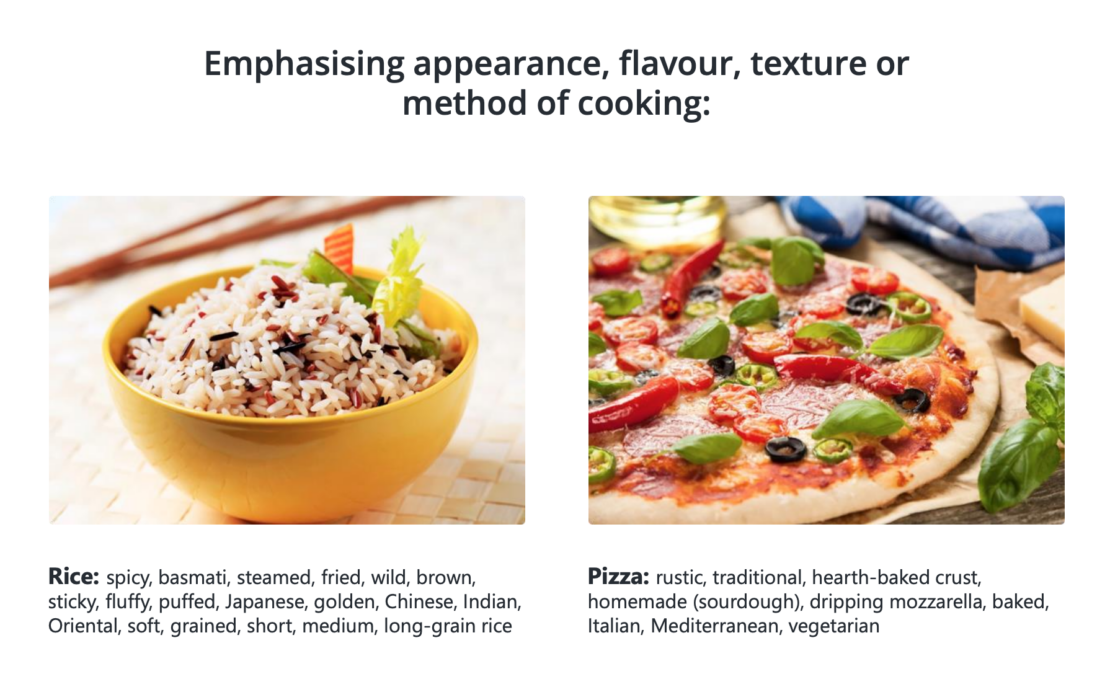
#5. Emphasize the cooking process in the restaurant food description
When you write a menu dish description, you have to answer the question: what makes it special? Why should customers choose this food item compared to others?
An inciting reason could be the way the dish was prepared, especially if it was a complicated or time-consuming one. Let’s say, you have these food description examples: “slow-cooked pork ribs in garlic marinade” and “pork ribs with garlic.”
The first one makes your mouth water instantly, you can just imagine how juicy the ribs will be, while the second one is correct, but only states the ingredients.
Here are some words you can use to highlight the cooking process in your food menu description:
- Pan-seared;
- Chargrilled;
- Slow-roasted;
- Marinated;
- Flambeed;
- Poached;
- Braised.
You don’t need to go to a restaurant description creative writing class, you know your food best. You know what ingredients you used, the story behind every dish, and what goes into cooking the menu items.
All you need are some striking words to take any food description for the menu to the next level and entice people to click the add to cart button. Here are a few examples:
- About texture: buttered, caramelized, crispy, leafy, tender, creamy, velvety, sticky
- About taste: zesty, aromatic, succulent, melt-in-your-mouth, tart
- About looks: elegant, vibrant
Check out these food menu description examples to get an idea about how you could use the previous illustrative words:
- “Pizza Siciliana: Fire-oven roasted dough, succulent Stracciatella, organic prosciutto cotto and authentic Sicilian pistachio”
- “Kimcheese – caramelized sourdough bread with sharp cheddar and vibrant punchy kimchi”
- “Carbonara pasta – creamy linguine with home-grown eggs, authentic guanciale, Italian pecorino and a splash of aromatic chili oil”
Humor sells and fun menu descriptions often end up on social media and get thousands of shares. That means free organic advertising with minimum effort.
After coming up with funny, descriptive menu words, you can enjoy the stream of incoming clients for months. However, not every restaurant can benefit from this, as it has to go with your overall branding and company’s tone of voice.

#8 Use good quality photos, but sparingly
Most upscale restaurants don’t use pictures in their brick-and-mortar location menu. There are several reasons for this decision.
The first one is because it makes the list longer and gives a cheap fast-food feeling. Another reason is that it creates certain expectations in the minds of the consumers that can lead to disappointment if the plate doesn’t look like the picture.
However, we advise you to use pictures to compliment your online restaurant menu descriptions because you don’t face printing constraints, and people are used to seeing visual cues in the digital world.
If you use GloriaFood’s online ordering system, you can upload a top quality image of your own or select one from the thousands available in our system, royalty free.
Below are instructions on how to add an online ordering menu to your restaurant website in 10 minutes.
When adding photos to your online menu, the key is to select the most mouthwatering ones and use them as examples for categories.
That, together with the use of attractive menu descriptions or adding text to photo, will make your menu shine. For example, take a look at the dessert section below. While the photos are great, it feels like something is missing, right?
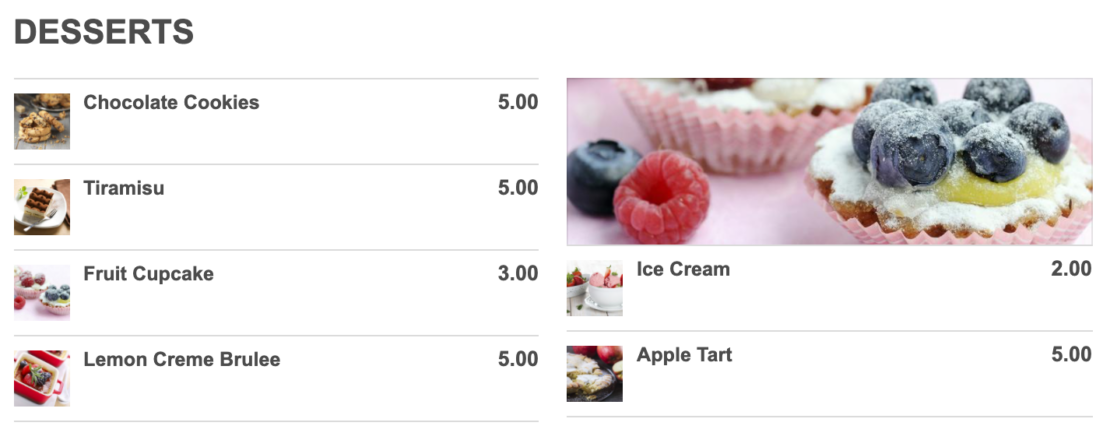
What if you added some show-stopping menu descriptions too? Your customers will definitely start craving your desserts.
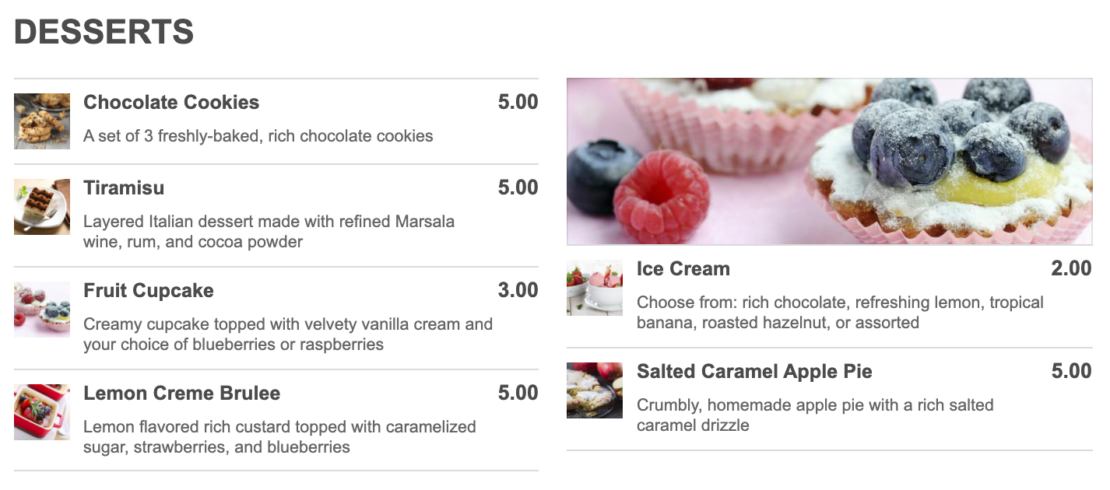
Did the desserts above make your mouth water? Here are more adjectives you can use to describe desserts on your restaurant menu.
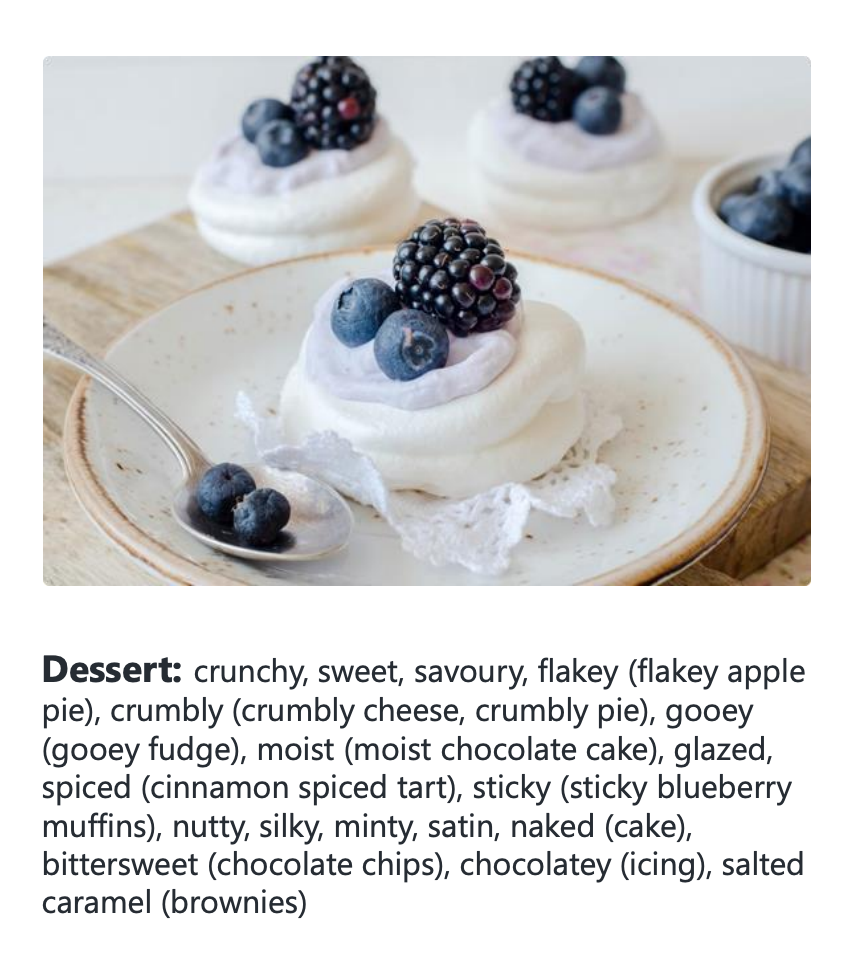
Images can also serve a secondary purpose: help SEO indexing of your website. If you use original pictures and name them accordingly, when someone searches for that dish, they might be drawn to your website from an image search.
Create an attractive online menu for pickup and delivery
Choose from the thousands of royalty-free professional photos in our library
Have you noticed one of your menu items is not selling as well as others? It may be the description!
Take a look at the best-selling items and try to emulate their description, experiment with funny words, focus on ingredients, story or location. Nothing is set in stone, so change the description until you get the best results.
But be patient and only make an update once every two weeks as to not confuse customers and have time to see if the sales increase.
With our online ordering system, updating menu items is a piece of cake. With just a few clicks, your changes go live instantly. Check out this video to learn how to create a restaurant menu with beautiful photos and mouth-watering descriptions:
#10 Menu writing mistakes you should avoid
As you probably learned by now, writing a restaurant menu that sells is not easy, but with a little practice, it can boost your profits. Here are a few of the most common pitfalls when writing menu descriptions.
You will serve clients from all walks of life, and they should all be able to read the menu and decide without googling.
Although we strongly advise you to use menu adjectives and descriptors which trigger the senses, don’t use cook-book terms. If some sentences are not up to the mark, don’t hesitate to rephrase them for maximum clarity. The final copy of your restaurant menu descriptions should be readable by a 7-year old child.
Stay away from negative words
Read your descriptions aloud to a public of family and friends to check for any negative sounding words. Try replacing these with more appetizing synonyms.
For example, when writing a dessert menu description, don’t mention sugary. Replace it with glazed, or honeyed. Never say burned when talking about a dish, but use charred. Something cooked in butter is never greasy, but velvety or smooth.
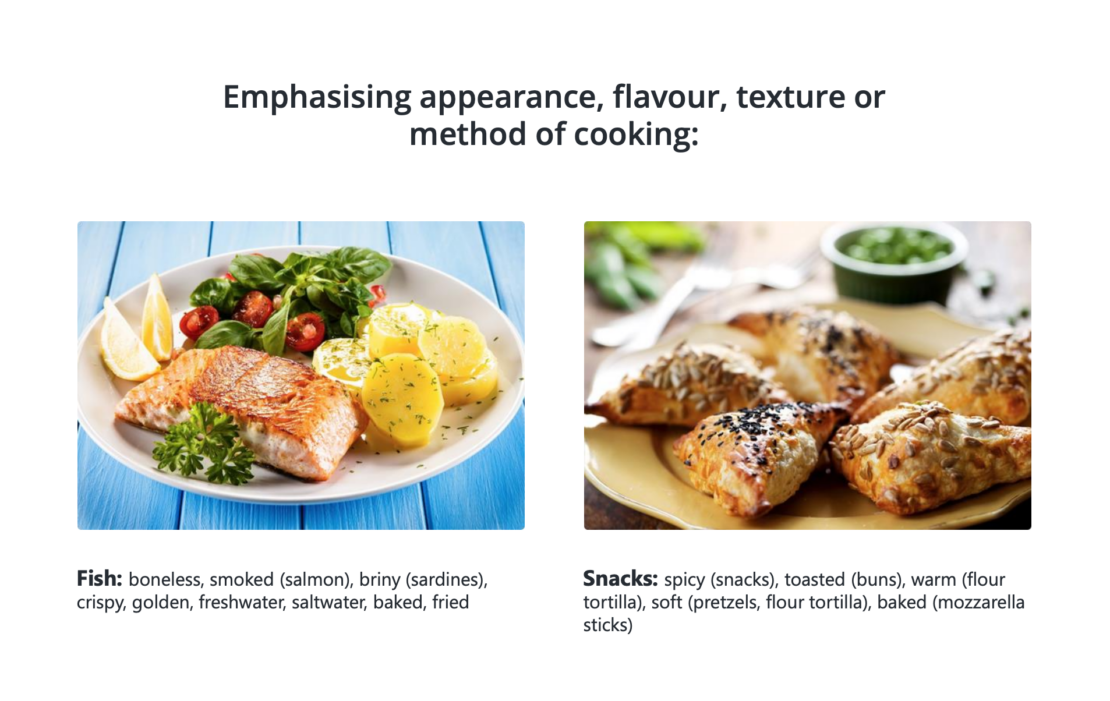
Eliminate currency signs
- Upscale restaurants don’t even put prices in their printed menus, but this is a risky maneuver. If you want to minimize the pain associated with paying, there are a few psychological tricks to take your customer’s mind off their wallets:
- Delete any currency signs from the menu. Neuromarketing research shows that seeing just a number makes clients spend twice as much compared to when the list has a currency sign.
- Place the price as close as possible to the name of the dish or the description to avoid price shopping if your items have substantial differences between them.
- Use a smaller font size for the price.
Menu variety is a good thing; people love to have choices. However, too many items on your menu list have the opposite effect as the “choice paradox” installs.
Keep your menu long enough to be interesting for most customers, but short enough so that they can decide in less than 109 seconds, which is the average time spent reading a menu.
Don’t ignore your audience
When you are searching for menu description examples, keep in mind that one size doesn’t fit all. What works for other restaurants in your area may not work for you, simply because you have a different audience.
Therefore, you must first identify what type of customers visit or order from your restaurant. Start with your cuisine. If your menu items are more on the pricier range with fancy ingredients, you should be on the lookout for fine dining menu descriptions, such as:
- “Pan-seared Saint-Jacques Scallops caught in the Mediterranean, served with a fresh vinaigrette of locally sourced wild berries and micro-herbs”
If you have a restaurant that promotes high-quality meat consumption, go for a steak menu description that emphasizes the type of meat and the cooking process. For example:
- “60-day maturated rib-eye cooked on wood-fired grill, served with an aromatic green salad and potato chips”
On the other hand, if you have a younger, hip, audience, use funny descriptions they can relate to. Start up a conversion on social media to find out your clients’ preferences, so you can best fit their style and motivate them to order more.
Furthermore, if you want to persuade clients into visiting your place again, consider implementing Wi-Fi email capture to build a database you can update on your menu items and promotions.
Create a menu that clients can't say no to
Install an online ordering system to your website for free
Conclusion
Implement these restaurant menu descriptions in your establishment and on your restaurant website to make your customers crave the food and order more. Keep in mind our menu description tips every time you craft a description for a meal.
If you don’t have a website yet, you can try our sales optimized website solution to get more clients to see your mouthwatering cuisine. Just click on “Get Started” below.
- Trigger the senses with longer menu food descriptions
- Use location to suggest quality
- Incorporate diets, customs and religion
- Create a nostalgic backstory for your restaurant menu items list
- Emphasize the cooking process in the restaurant food description
- Use these restaurant menu descriptions examples to draw inspiration from
- Write funny menu descriptions of food
- Use good quality photos
- Update your restaurant menu descriptions to keep the content fresh
- Menu writing mistakes you should avoid
- Don't use complicated menu description words
- Stay away from negative words
- Eliminate currency signs
- Don't make the menu too long
- Don’t ignore your audience

